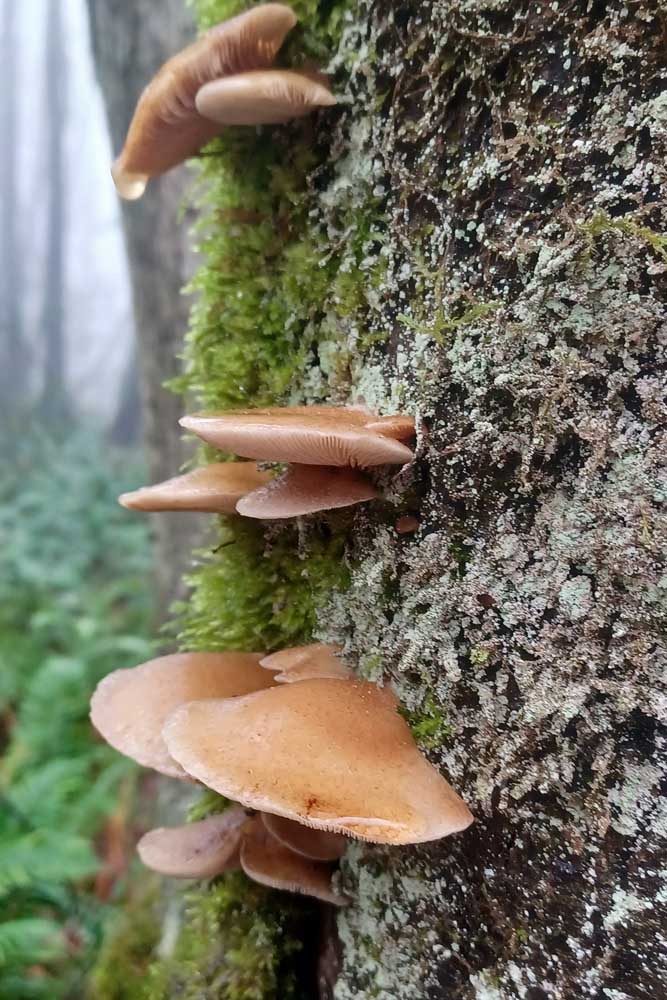Rainy Rambles: A farewell to fall fungi
Published 9:00 am Tuesday, December 10, 2024

- Late fall oyster mushrooms sprout from tree bark.
Last week, I ventured out into the shore pines in search of my favorite edible mushroom, the saffron milk cap, or Lactarius deliciosus.
While it doesn’t have the popularity of chanterelles or morels, I’m just fine with other people overlooking it in favor of higher-demand species, because that means there’s more for me.
The fall mushroom starts out as a bright reddish-orange, but with age and damage, it takes on a greenish hue, which often camouflages it from the eyes of passersby.
Its flavor is decent — after all, its Latin name translates as “delicious” — but what endears it to me is the texture. When thoroughly cooked, but not overly so, the saffron milk cap retains a distinct firmness bordering on a fleshy crunch, and I am at least as interested in texture as taste.
When I find these milk caps, I like to saute them in butter, and perhaps add the cooked leftovers to an omelet or scramble.
By the end of November, though, these mushrooms have largely run through their fruiting season. But I take a peek this time of year anyway, just in case the mycelium weaving its way through the soil of the shore pines decides to burst forth with one last little hurrah.
Happily, I was rewarded with a half dozen nice specimens amid several that were too far gone toward the side of rotting — just enough to make a nice side dish over brown rice.
Lactarius deliciosus isn’t native to the Pacific Northwest. Instead, it was introduced with pine trees from the Mediterranean region of Europe, where it’s given more consideration than it is stateside.
But the mycelium is perfectly happy to wrap around the roots of coastal shore pines, where the two species share nutrients in a mycorrhizal relationship.
The fungus breaks down decaying matter in the soil and sends it along with some water into the trees’ roots, while the pines deliver some of the sugar they create from sunlight through photosynthesis.
Not all fungi will partner with the shore pines, and vice versa, but these amicable trees are mycorrhizal with Lactarius and Russula species, as well as the edible king bolete (Boletus edulis) and the bright but toxic fly agaric (Amanita muscaria).
My find probably represents the last of the milk caps I’ll find this season. It’s been a great fall for fungi, but all good things must come to an end. A colony of mycelium only has so much energy it can put toward reproduction, and as winter approaches, it’s time to take a break and start building up reserves again for next year.
Within a few weeks, the only edible species I might be lucky enough to find before the first hard freeze would be the late oyster mushroom (Sarcomyxa serotina), perhaps on a rotting conifer log, or a handful of yellowfoot (Craterellus tubaeformis) or hedgehogs (Hydnum repandum) hidden on the floor of a mixed-conifer forest, away from the hunched forms of the shore pines.
For the moment, though, my little clutch of milk caps is a boon. And these I get to have all to myself, for they’re the only wild mushrooms I’ve found that my partner can’t have. It’s not poisoning, mind you. Just as some people have dairy allergies or gluten intolerances, some people can’t eat certain wild mushrooms, even when properly prepared.
That’s why it’s best to only try a few small bites of a new edible mushroom for the first time, even when it’s been purchased from a store or market.
It speaks to part of why I find mushroom hunting so compelling. This is not just a matter of walking into the woods and picking whatever fungi I see. It’s a challenge that requires me to bring forth the best of my observation and critical thinking skills as I puzzle out each species I meet.
In the Columbia-Pacific region, the price for eating the wrong species is more likely to be over an unpleasant night than a dissolved liver, but that’s no reason not to take the utmost care. And as winter unfolds over the land, it will be a good time for me to curl up with my field guides to familiarize myself further with now-sleeping fungi, and dream of adventures in the year to come.




